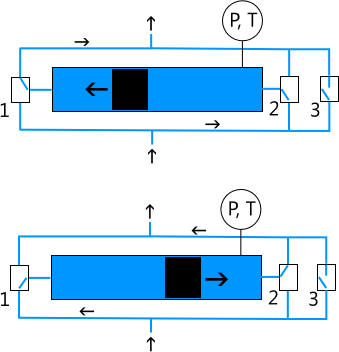

Precision in sensing
EC Instruments AB | Reg. no. 556818-0268 | Sveavägen 47 | SE-18262 Djursholm | SWEDEN
A piston is placed inside a tube. When gas or liquid is led into the tube on one side of the piston it will make the piston move. Which side the gas/liquid is led in on is controlled by two valves ("1" and "2" in figure). By switching state of the two valves simultaneously the piston is made to reciprocate (i.e. travel back and forth) within the tube.
By continuously measuring the position of the piston along the stroke the displaced volume can be calculated as the diameter of the piston is known. The flow rate is calculated as the change in displaced volume over time. The flow measurement is continuous as it is done during both directions.
This can be compared with the traditional "piston prover" flow meter which only takes samples of the flow rate. In this case the tube is oriented vertically and as the the gas stream is switched into the tube by a valve, the piston is moved upwards. When the piston reaches the end of the tube the gas is switched to bypass the meter and the piston is lowered to a starting position by gravity. The flow rate is only measured as the piston is moving upwards which makes the measurement to be only a sample of the actual flow rate. Often only a mean flow rate is displayed, based on the time it takes for the piston to travel between two end points of the tube.
Piston / tube
The piston is precision machined to fit into the tube with extremely narrow tolerances. It is made of graphite and the tube is made of borosilicate glass, a combination of materials that make a very good match in terms of similar thermal expansion and low friction. This makes it possible to achieve a virtually leak free viscous seal.
The measurement is volumetric and directly derived from physical quantities as distance (travel and diameter) and time, which makes it close to a primary standard.
Precision position sensing
The position of the piston is continuously measured very precisely. The continuous measurement makes it possible to present a continuous flow curve, it is not just an average between the two turning points.
Normalization
With the built in precision pressure and temperature sensors conversions to normalized flow is made. See section Volume flow vs Mass flow for more information about volume and mass flow and different standards.
Bypass
A bypass valve ("3" in figure) is used for bypassing the gas flow when the instrument is shut of or in "Standby" mode.
Pros and cons
The main pros of the ReciFlow are:
- Accuracy and high resolution.
- Long term stability.
- Fast response.
- Large dynamic range.
- Corrosion resistant wetted materials (see data sheet).
Although there are many pros there are, as with any kind of flow meter, of course some cons:
- As the piston reciprocates it will change the "order" of the gas sections in a stream. The principle "first in first out" is not applicable here. If for example analysis of the gas concentration is to be done downstream of the flow meter this effect has to be considered.
- The lifetime of the flow meter is limited by the valves used for switching the direction of the flow. Due to this the flow meter is not suited to be permanently installed to measure high flow rates. For detailed info, see data sheet. The valves can however easily be replaced at factory service.
Basic working principle

